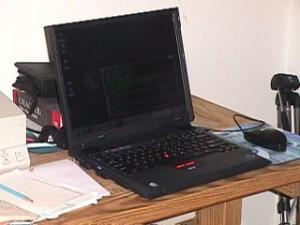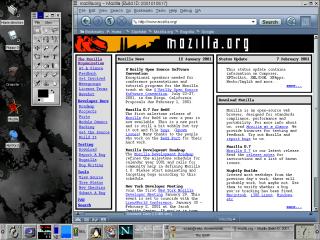
I went for the larger screen rather than a faster CPU, as I'd rather have a larger screen than a faster CPU. I was lucky to buy my computer during a promotional period and I got a Kodak EZ 200 digital camera for free.
I wanted to keep Windows 98 on the computer, mostly for because I need to use Window's software at work. The computer came with a single partition. I decided to split the partition into two parts: 3 Gig for Windows and 7 Gig for Linux.
I tried to use FIPS to split the partition, but FIPS was unable to move some disk blocks at the end of the C partition. So instead I bought Partition Commander to repartition the disk. It's a program similar to Partition Magic
I used Partition Commander to cut down the Windows partition downto 3 Gigs. Partition Commander also installed a boot manager, but I removed it (using FDISK /MBR).
I installed Red Hat 6.2, as I'm pretty familiar with Red Hat installs and have done several Thinkpad installs. I created three partitions for Linux: root partition, home partition and a swap partition. Here is output of df on my machine:
Filesystem 1k-blocks Used Available Use% Mounted on
/dev/hda2 1034244 862824 118880 88% /
/dev/hda6 5476688 1413632 3784852 27% /home
/dev/hda1 3063328 950856 2112472 31% /dos/c
The root partition is about 1 Gig, the swap 256M and /home covers the rest. I always mount the Windows partition under "/dos/c" mount point.
Other than that I picked "Gnome Workstation" as an install option and let the installer continue from there. To boot the system I've set up LILO with Linus as the default. Here is my lilo.conf file:
boot=/dev/hda map=/boot/map install=/boot/boot.b prompt timeout=50 linear default=linux image=/boot/vmlinuz-2.2.14-5.0 label=linux read-only root=/dev/hda2 other=/dev/hda1 label=dos

X windows configuration was straightforward with Xconfigurator. It detected the right display chipset. I picked Custom monitor and chose non-interlaced SVGA monitor with Vertical refresh of 50 to 90.
I picked PS/2 mouse. This way the computer works with the trackpoint device or with a PS/2 mouse plugged in the back. However to switch between the two the system has to be rebooted. I haven't yet figured out how to switch between pointing devices - restarting the X server does not work.
I set the display to 1024 by 768 with depth of 16 pixels. You can look at my XF86Config here.. A screenshot of my desktop appears on the right (I use Gnome and Enlightment - the default Red Hat set up).
The Thinkpad comes with a built-in Win modem. I didn't bother with it, as I had a Xircom RealPort Ethernet/Modem card and I used it. It worked right out of the box. I plugged in the card and I was able to bring up the network.
I used Red Hat's tool to configure the PPP connection. It recognized the Xircom modem and set up PPP without any problems.
Red Hat sound configuration tool does not recognize the chipset used by the A21e. It just says Unknown Intel chip. I had a hard time figuring out what chipset is used for sound in the A21e. Turns out that the other A-models use different chipsets for sound. I couldn't find this information on IBM's web site.
Finally I found the specifics on Linuxcare Thinkpad page here: http://www.linuxcare.com/labs/certs/ibm/thinkpad/A21/pad21e-rh70.epl
Once I figured out which chip it was, all I had to do is download and install ALSA drivers from http://www.alsa-project.org web site and then configure the /etc/conf.modules file. Here is what it looks like:
alias parport_lowlevel parport_pc # ALSA portion alias char-major-116 snd alias char-major-14 soundcore alias snd-card-0 snd-card-intel8x0 alias sound-slot-0 snd-card-0 alias sound-service-0-0 snd-mixer-oss alias sound-service-0-1 snd-seq-oss alias sound-service-0-3 snd-pcm-oss alias sound-service-0-12 snd-pcm-oss
The only problem I have with sound is that when the machine boots the sound is not on and I have to start the mixer to enable it. Other than that sound works.
Overall I'm very happy with my Thinkpad. The one thing that bothers me a little is the placement of the "Ctrl" key. It has an "Fn" key to it's left, and when I use Emacs I often press the "Fn" instead of the "Ctrl" key.
The suspend feature seems to work fine with Linux. I haven't tried deep sleep.
To speed up the disk I/O I added the following lines to the /etc/rc.d/rc.sysinit file:
# Change HD paramters to speed up disk access /sbin/hdparm -c3 -d1 /dev/hda
When the external mouse if plugged in the trackpoint device doesn't work. If you plug in the mouse after the system is up, the mouse will not work. By accident I discovered that if you suspend the machine and unplug (or plug in) the mouse while the computer is suspended then the trackpoint works fine.